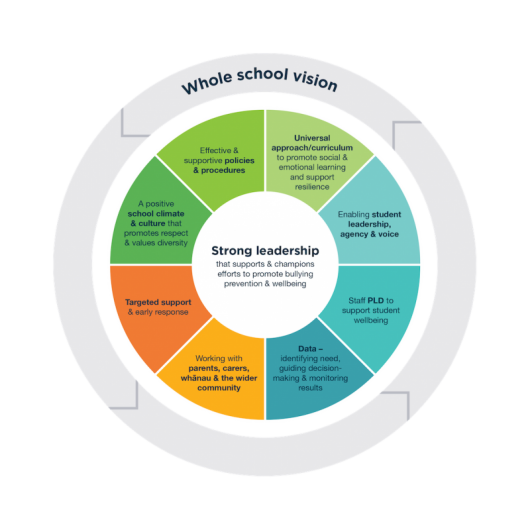Prevent Bullying
Thank you for visiting.
This content is being reviewed and updated, and will be moved to a new website.
We will keep you updated as this happens.
If you have any queries, please email: [email protected]
Most widely-accepted definitions of bullying are based on four elements: bullying is deliberate, harmful, involves a power imbalance, and has an element of repetition.
Evidence shows that bullying is more than an interaction between individuals, but rather occurs because of what happens in peer groups, families, schools, communities and the wider social environment. This means that schools need to have solutions which focus on a range of elements to prevent and respond to bullying.
Working together
When the whole school community, students, staff and whānau work together to address bullying, positive, ongoing change happens.
Bullying prevention approaches need to align with the values, goals and priorities of your school community so are likely to look different in each school.
Prioritising student wellbeing by building a safe, caring and inclusive environment, is central to preventing and responding to bullying. Focusing on wellbeing can also support schools to address racism and discrimination, as well as support attendance and engagement.
PB4L initiatives like PB4L School-Wide and Restorative Practice can strengthen bullying prevention and response efforts by providing evidence informed and holistic approaches to supporting a safe school culture where positive relationships are prioritised.
A whole-school approach: the Bullying-Free NZ School Framework
Preventing and responding to bullying works best when the whole school community gets involved. Research indicates there are nine elements to an effective whole-school approach.
To find out more about whole school approaches to addressing bullying visit bullyingfree.nz, our dedicated bullying prevention and response resource hub. This site provides a wide range of information and resources including:
- A whole-school approach to bullying prevention
- The Bullying-Free NZ Framework
- A guide for Boards of Trustees
- Steps to tackle Bullying: A roadmap for schools
- Tackling bullying: A guide for parents and whānau
Tips for success
- Establish a team to drive the work. Ensure school leadership are involved and informed.
- Involve the whole school community (students, teachers, all school staff, parents and whānau) in designing, delivering and reviewing a plan for change that considers all layers of the wider social environment.
- Gather and make use of data on what happens and how people feel about life at school
- Work to continuously strengthen connections with all family and whānau
- Support social and emotional skill development in everyday learning. Teach, model and practice positive relationships and problem solving.
- Set up processes to monitor, review and improve upon planning.


